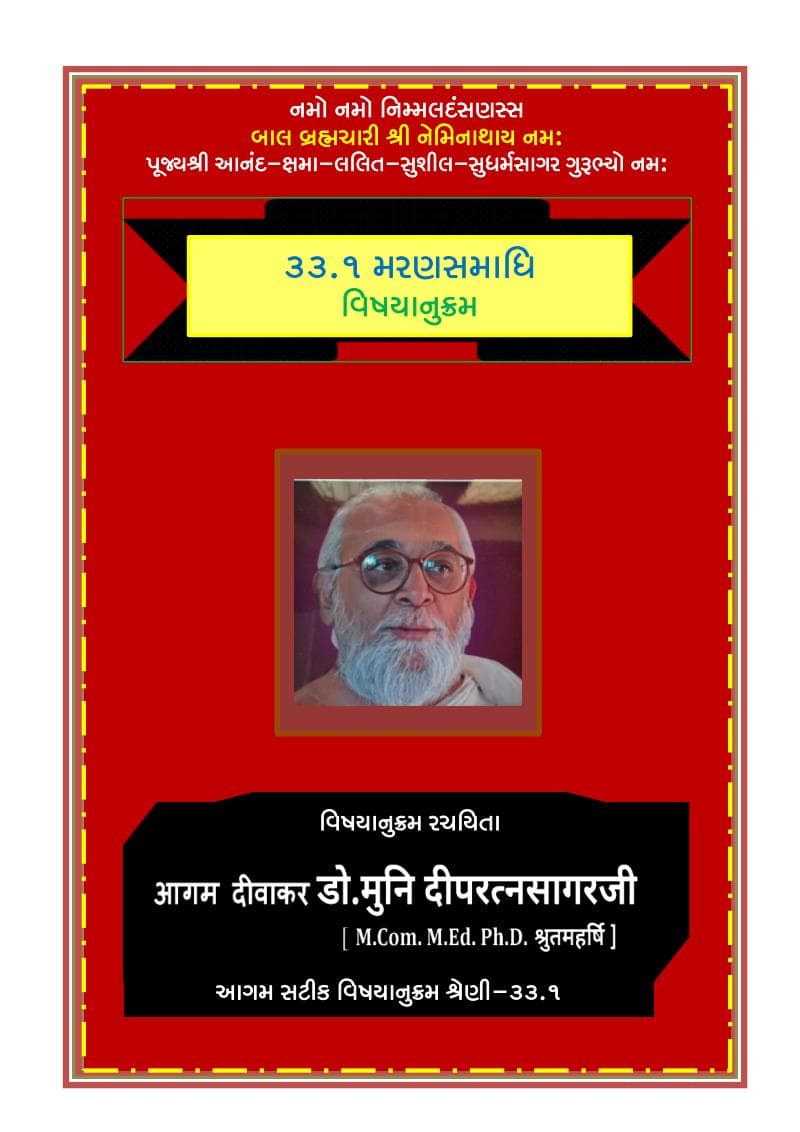33 01 Maransamadhi Satik Vishayanukram
Added to library: September 1, 2025

Summary
Based on the provided catalog link and the title "33-01 Maransamadhi Satik Vishayanukram," here's a comprehensive summary of the Jain text:
Book Title: 33-01 Maransamadhi Satik Vishayanukram Author(s): Dipratnasagar, Deepratnasagar Publisher: Dipratnasagar, Deepratnasagar Catalog Link: https://jainqq.org/explore/033934/1
Summary:
The Jain text "Maransamadhi Satik Vishayanukram" is a detailed exposition on the Jain concept of Maransamadhi (also known as Sallekhana or Santhara), which is the voluntary and conscious renunciation of food and drink leading to death. The title itself, "Maransamadhi Satik Vishayanukram," can be broken down to understand its essence:
- Maransamadhi: This term refers to the serene and contemplative state of mind achieved at the time of death, specifically in the context of embracing a planned and spiritual end to life. It signifies a voluntary and peaceful departure from the physical body.
- Satik: This likely implies something that is "with a stick" or, more metaphorically, "with a guide" or "supported." In this context, it suggests that the text provides a methodical, step-by-step, or guided approach to understanding and practicing Maransamadhi.
- Vishayanukram: This translates to "subject matter index" or "table of contents," indicating that the book is structured to systematically cover various aspects and details related to Maransamadhi.
Therefore, "Maransamadhi Satik Vishayanukram" is a guided index or systematic overview of the subject matter concerning the practice and understanding of Maransamadhi in Jainism.
Key Themes and Content (Inferred from title and Jain doctrine):
While the catalog link doesn't provide the full text, based on Jain philosophy and the nature of Maransamadhi, the book likely covers the following:
-
Theological and Philosophical Basis:
- Karma Theory: How Maransamadhi is seen as a means to exhaust negative karma and attain a better rebirth or liberation (Moksha).
- Ahimsa (Non-violence): Addressing the perceived paradox of voluntary death with the principle of Ahimsa, emphasizing that Maransamadhi is not an act of violence against oneself but a culmination of spiritual discipline and detachment.
- Detachment (Vairagya): The importance of cultivating a deep sense of detachment from worldly pleasures, possessions, and even life itself as a prerequisite.
- Right Faith, Right Knowledge, Right Conduct (Ratnatraya): How Maransamadhi is the ultimate expression of these three jewels in the face of death.
-
The Practice of Maransamadhi:
- Eligibility and Conditions: Who is eligible to undertake Maransamadhi (e.g., serious illness, old age, without fulfilling worldly duties).
- Stages of Practice: The gradual renunciation of food and drink, accompanied by increasing spiritual practices.
- Mental and Spiritual Preparations: The importance of contemplation, meditation, study of scriptures, and seeking blessings.
- Role of the Community and Ascetics: The support and guidance provided by Jain monks, nuns, and the lay community.
- Ethical Considerations: The strict ethical guidelines and precautions to ensure the practice is undertaken with pure intention and without any coercion.
-
The Significance and Benefits:
- Purification of the Soul: How it helps in purifying the soul from accumulated karmas.
- Attainment of Liberation (Moksha): The ultimate goal of achieving liberation from the cycle of birth and death.
- Peaceful and Dignified Death: The emphasis on a calm, conscious, and spiritual end to life.
- Inspiration for Others: The exemplary nature of such a disciplined and detached departure from life.
-
Controversies and Misconceptions:
- The book might also address common misunderstandings or criticisms of Maransamadhi, particularly in a modern context, and clarify Jain perspectives on these issues.
Authorship:
The repetition of the author's name as "Dipratnasagar, Deepratnasagar" suggests a single author or a closely collaborative effort, likely an esteemed Jain scholar or spiritual figure associated with the publication. The publisher being the same as the author(s) often indicates a self-published work by an authority.
In essence, this book serves as a comprehensive guide for understanding and appreciating the profound Jain practice of Maransamadhi, detailing its philosophical underpinnings, practical execution, and spiritual significance. It aims to provide a clear and structured insight into this unique aspect of Jain spiritual discipline.